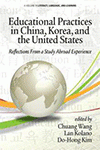
Educational Practices in China, Korea, and the United States
Reflections from a Study Abroad Experience
Edited by:
Chuang Wang, University of North Carolina at Charlotte
Lan Kolano, Cato College of Education, UNC Charlotte
Do-Hong Kim, Augusta University
A volume in the series: Literacy, Language and Learning. Editor(s): Claudia Finkbeiner, Universitaet Kassel. Wen Ma, Le Moyne College.
Published 2020
This book is written by a diverse cohort of both of American educators, including professors, teachers, school counselors, and school administrators from pre-K to college levels. Most of the contributors come from disciplinary areas of English as a second language and school administration. With the pressure of Common Core State Standards Initiative, American educators are now shifting their focus to standards-based instruction. Meanwhile, Chinese educators are moving away from national standards and developing state level curriculum and instruction to meet specific needs of the students in local provinces. There is also a debate about whether or not to use the National College Entrance Examination as the only test for college admission. Some provinces (e.g., Zhejiang and Hubei) are administering their own college entrance examinations. The book outlines the sociocultural roots of education in the three countries, linking the tradition and philosophical orientations to each country's own history of education. Furthermore, the book compares and contrasts the curriculum, especially the teaching of English as a second/foreign language, in three countries.
This book examines the stress of students, physical education, various pedagogical styles in foreign language education as well as instructional texts and cross-cultural dialogue between teachers. Additionally, the book explores factors that influence parent's involvement and women's educational and career aspirations. Lastly, the book presents modern technologies such as smart learning technologies and online learning platforms not only to facilitate future educational systems but also to promote international exchanges.
The chapters of the book are thematically diverse, but they help to provide inspirations for educators both in American and Asian countries. The findings offer alternative practical lenses for educational community to seek for some "middle ground" between Chinese, South Korea and American education. The intended audience for this book is graduate students, teachers, administrators, and professionals in education.
CONTENTS
Introduction: Chinese, Korean, and American Education: Foundations and Practices, Chuang Wang, Lan Kolano, and Do-Hong Kim. PART I: INFLUENCE OF CULTURE, PARENTAL INVOLVEMENT, AND ECONOMY. How Culture Influences Gender Roles and Expectations in Chinese Culture, Yolanda Kennedy and April Smith. Factors That Influence Parent Involvement in an Educational Context in the United States, China, and South Korea: Benefits and Barriers, Elizabeth M. Landon and Peter L. Johnson. A Comparison Study on the Effects of Parental Involvement, Teacher Ability, and Socioeconomic Status on Academic Achievement in the United States, China, and South Korea, Kathryn Wagner and Lauren Schmidt. Education and the Economy: An Examination Into the Effectiveness of Education in China, the United States, and South Korea, Taylor Allen and Michelle Chen. PART II: TEACHING AND LEARNING. Comparative Analysis of Instructional Texts and the Cross-Cultural Dialogue Between Teachers: Scenes From a Chinese and an American Classroom, Laurie Dymes. Comparisons of Teaching English as a Second Language in the United States and China, Kelsey Alvarez and Jessie Lay. English as a Foreign Language and Foreign Language Education in the United States, China, and South Korea, Jennifer James. Student Fitness Abroad: A Comparative Analysis of Physical Education in the United States, China, and South Korea, Jessica Kapota, Hongjun Qiu, and Gwitaek Park. PART III: NEW PEDAGOGICAL FRAMEWORK AND PRACTICES. Chinese and South Korean Education Reformations: Unrealistic Expectations in the Implementation of Western Pedagogy, Cory Alexander. How Smart Learning Is Defined: An Analysis of 27 Definitions by Korean Scholars, Kiran S. Budhrani. 21st Century Classroom: Finding the Right Balance, Florence Martin. Culturally Speaking: Comparing Culturally Relevant Pedagogy in Chinese, Korean, and American Classrooms, Lori J. Williams. PART IV: CONCLUSION. Conclusion: Implications for Teacher Education, Lan Kolano, Chuang Wang, Michelle Pazzula, and Do-Hong Kim. About the Contributors.
-
Paperback978-1-64113-876-5
Web price: $45.04 (Reg. 52.99)
-
Hardcover978-1-64113-877-2
Web price: $80.74 (Reg. 94.99)
- eBook978-1-64113-878-9

- EDU005000 - EDUCATION: Bilingual Education
- FOR003000 - FOREIGN LANGUAGE STUDY: Chinese
- FOR000000 - FOREIGN LANGUAGE STUDY: General
-
 Authentic Voices
Culturally Responsive Teaching and Learning
Authentic Voices
Culturally Responsive Teaching and Learning
-
 Chinese Education from the Perspectives of American Educators
Chinese Education from the Perspectives of American Educators
-
 Collaborative Learning in a Global World
Collaborative Learning in a Global World
-
 Innovative Approaches to Teaching Multilingual Students
Innovative Approaches to Teaching Multilingual Students
-
 Listening to the Voices of Boys
Exploring the Motivation of Primary Boys to Engage in Reading
Listening to the Voices of Boys
Exploring the Motivation of Primary Boys to Engage in Reading
-
 Reconceptualizing Literacy in the New Age of Multiculturalism and Pluralism
2nd Edition
Reconceptualizing Literacy in the New Age of Multiculturalism and Pluralism
2nd Edition
-
 Views from Inside
Languages, Cultures, and Schooling for K‐12 Educators
Views from Inside
Languages, Cultures, and Schooling for K‐12 Educators

